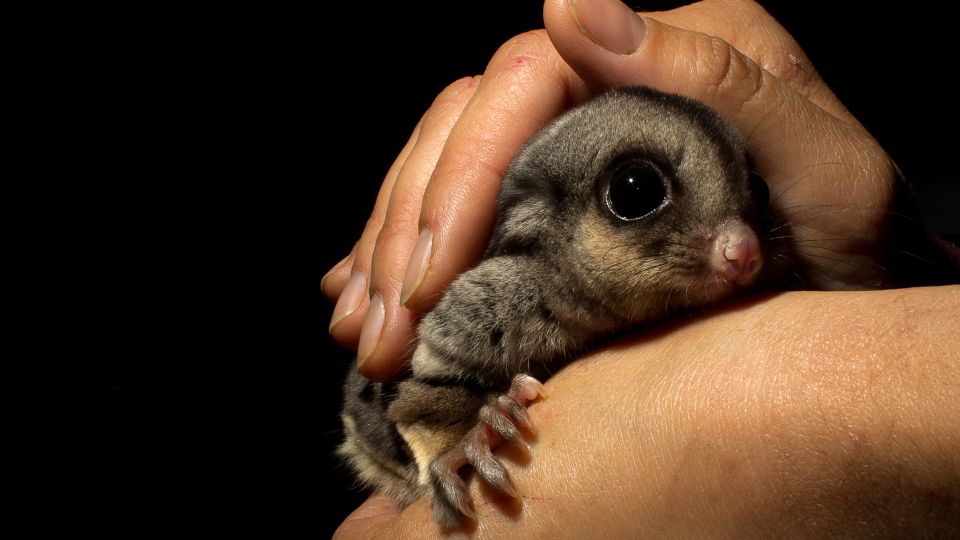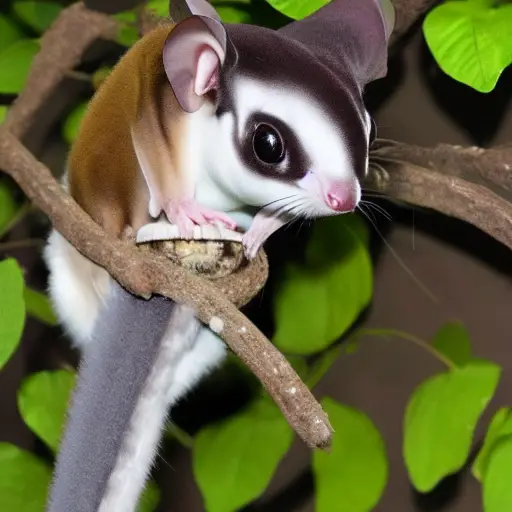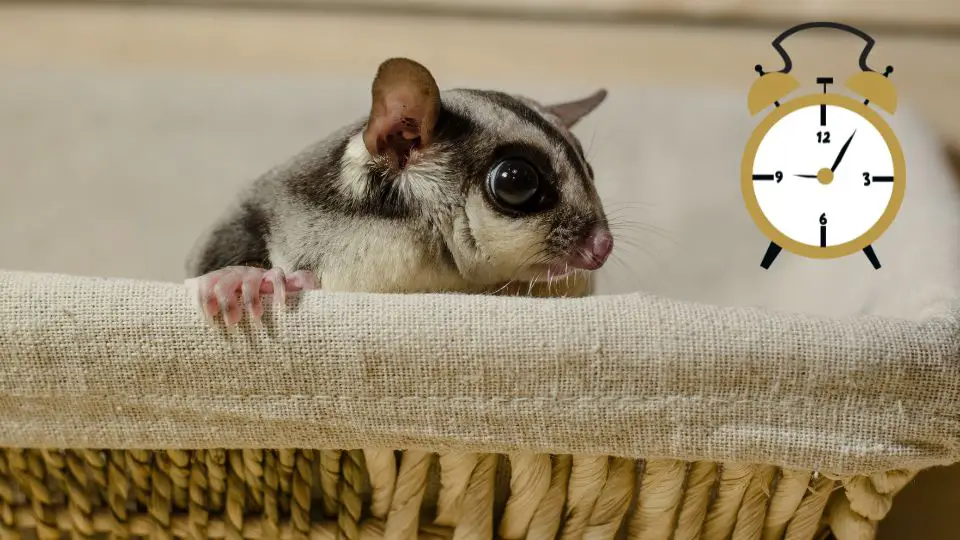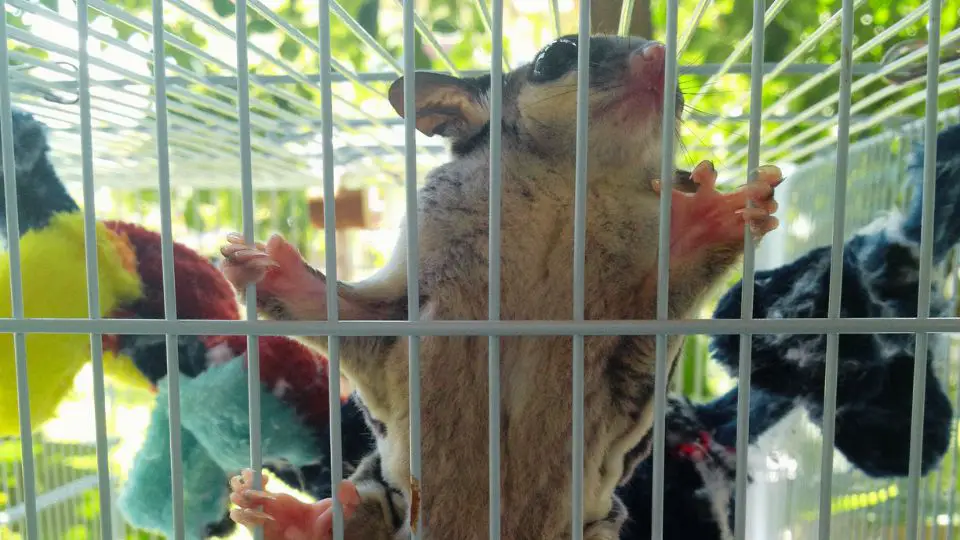When it comes to sleeping habits, sugar gliders are nocturnal animals and sleep for around 12 hours each day. Their sleep-and-wake cycle has enabled them to survive in harsh environments and endure predators.
However, their nocturnal schedule makes them very active during the night, and owners may wonder how to train their pets to change this schedule.
How long do sugar gliders sleep
Sugar gliders are nocturnal animals, which means they sleep during the day and are active at night. They typically sleep for around 12 hours each day.
Because sugar gliders are nocturnal, you will need to adjust their sleeping schedule. Changing the hours of day or night can disrupt the animal’s sleep cycle, and it is important to avoid disturbing this schedule for your glider’s well-being.
Even if you use blackout curtains or correct light bulbs, you must do it gradually. The longer you delay their sleep, the more frightened they will be.
Where do sugar gliders sleep?
Sugar gliders usually nest in tree hollows or other sheltered areas. During the day, they will often curl up together in a ball to stay warm. At night, they will emerge from their nest to forage for food and socialize with other members of their colony. As a result, sugar gliders need a secure, private area to sleep during the day in order to stay healthy and happy.

Most pet sugar glider will sleep in their cage. If you have only one sugar glider, you may opt to let it sleep in a bonded sleeping pouch with you. This way, the glider can feel safe and secure while it sleeps, and you can bond with your pet.
Is your sugar glider oversleeping?
Sugar gliders can oversleep for a variety of reasons. If your sugar glider is sleeping more than 12 hours a day, it could be a sign of illness. Also, if your sugar glider is sleeping during the night and awake during the day, it could be a sign that its sleep schedule is off.
Most of the time, it is nothing you should be wary about. It could be the change in their environment, or they might be going through a growth spurt. When in doubt, always consult with your veterinarian.
What are a sugar glider’s sleeping habits?
A sugar glider’s sleeping habits vary depending on the season. During the winter months, when they go into torpor, they may sleep for up to 16 hours. During the summer, they may only sleep for a few hours, wake up, eat, play a little and go to sleep again. But their average time they sleep remains 12 hours.
What time do sugar gliders wake up?
Sugar gliders don’t have a fixed wake-up time. They may wake up at dusk or dawn, depending on the season. But most of the time, they will be up and about 2-3 hours after sunset, and they go back to sleep when it starts to get light out.
If you have a pet sugar glider, it is best to let them adjust to your schedule. They may not be able to sleep through the entire night, but they will eventually get used to your sleeping habits.
Do sugar gliders hibernate?
Sugar gliders don’t hibernate, but they can go into torpor. Torpor is a state of reduced metabolism and body temperature. There are several reasons why sugar gliders enter torpor, most common is to conserve energy during the winter months. Another reasons are lack of food or water, stress, and illness.
During torpor, sugar gliders will sleep for long periods of time and wake up only to eat. They may also be less active and have a lower body temperature.
Do you need to be quiet around your sleeping glider?
You don’t need to be completely silent when your sugar glider is sleeping, but you should avoid making loud noises. Sugar gliders are very sensitive to sound, and loud noises can startle them and disrupt their sleep. If you need to make a noise, try to do it gradually so that your sugar glider can adjust.
Nevertheless, we recommend keeping your pet’s cage in a quiet place during the day so that your glider can get the rest it needs.
How to help your sugar glider to sleep
If your sugar glider has problems sleeping, there are some things you can do to comfort him and help him fall asleep.
Have the cage in a quiet place
Make sure that his cage is in a quiet place where he won’t be disturbed. A dark room is often best, as it will help him to feel sleepy.
Offer a sleeping pouch or a nesting box
Give him a soft, comfortable place to sleep. A sleeping pouch is a good option, as it will make him feel safe and secure. However, most sugar gliders prefer a nesting box.
If you opt for a nesting box, make sure that it is lined with soft material such as fleece or cloth. You can also put a blanket or towel over the top of the box to make it darker and more cosy.
Give him plenty of toys
Provide your glider with a toy or two to keep him occupied during the night so that he doesn’t get bored. This way he can also use his energy to play instead of running around and keeping himself awake.
You can also put a TV or radio on low volume in the room to give him some background noise.
Don’t handle him before bedtime
Don’t handle him too much before bedtime so that he doesn’t get too excited and has a hard time falling asleep. Or if the glider is new in your family, he might be stressed from the new environment and need some time to get used to everything and everyone. Let him sleep as much as he needs to during the day so that he can be well rested at night.

Can you change a sugar glider’s sleeping habits?
Unfortunately, changing your sugar glider’s sleeping habits is not recommended for the health of the animal. Gliders are nocturnal creatures for a reason and waking them up will put them in a state of stress. This can lead to aggression, biting, or even health problems.
If you want your glider to sleep less during the day, you can try to trick it using black out curtains and some specific light bulbs. But please note that this is not a natural way for a glider to change its sleep schedule, and we only recommend it as a last resort.
When adjusting your sugar glider’s sleeping schedule, it’s best to do it gradually. You don’t want to switch them from nocturnal to diurnal sleeping at once. Also, you will want to keep other routines, like meals and playtime, the same. A sudden change in schedule can be confusing and stressful for your glider.
The most important thing to remember is that you should never try to force your sugar glider to sleep during the day or night. They are nocturnal animals, and their bodies are designed to sleep when it’s light and be awake when it’s dark.
Should you change a sugar glider’s sleeping habits?
Sleep is incredibly important for sugar gliders. In the wild, they sleep huddled together in tree hollows during the day, coming out at night to forage for food. This natural sleep schedule helps them to avoid predators and stay safe.
However, in captivity, sugar gliders can be kept on a nocturnal schedule, meaning they are awake at night and sleep during the day. While this may be convenient for their human owners, it isn’t necessarily ideal for the sugar gliders themselves. Some experts believe that it is best to keep sugar gliders on their natural schedule, as this is what they are accustomed to.
Others argue that it is possible to gradually change a sugar glider’s sleep habits so that they are more aligned with their human family’s schedule. Ultimately, it is up to the owner to decide what is best for their pet. However, it is important to remember that any changes should be made gradually and with the sugar glider’s well-being in mind.
Will sugar gliders keep you awake at night?
Well, sugar gliders are most active at night so they may make noise and want to play when you are trying to sleep. There some tips you can use to stop this.
First, you can try to keep your glider’s cage in a room that is far away from your bedroom. This way, the noise will be less likely to bother you. Secondly, you can give them something to do at night so that they are not as active. This could be a toy or a treat. Finally, as we already discussed, you can try to gradually adjust their sleep schedule, but it is not recommended.

Although it’s true that sugar gliders can be loud at night, it also depends on their personality. Some gliders are more active than others, and some are just naturally quiet. So, you may have luck with a less active glider who is not as likely to keep you awake at night.
Are sleeping pouches or nesting boxes better for sugar gliders?
When sugar gliders are kept as pets, it’s important to provide them with a safe and comfortable place to sleep. There are two main options for doing this: sleeping pouches and nesting boxes.
Both have their advantages and disadvantages, so it’s important to choose the option that best suits your pet’s needs. Sleeping pouches are soft and warm, making them ideal for snuggling. However, they can be pricey, and some sugar gliders may prefer more privacy.
Your glider may also try to remove the fleece from the sleeping pouch which can be a choking hazard. So, it’s important to keep an eye on your pet if you choose this option.
Nesting boxes, on the other hand, offer a more natural environment and most sugar gliders prefer them. They’re also usually less expensive than sleeping pouches. However, nesting boxes can be difficult to clean.
How often should you clean your sugar glider’s sleeping pouch?
It’s important to clean your sugar glider’s sleeping pouch regularly, as it can become a haven for bacteria and parasites. Ideally, you should clean the pouch every two weeks. However, if your glider is sick or has diarrhea, you should clean it more frequently.
When cleaning the pouch, it’s important to use a mild soap and avoid any harsh chemicals. You should also make sure that the pouch is completely dry before allowing your sugar glider to use it again.
How often should you clean your sugar glider’s nesting box?
It’s also important to clean your sugar glider’s nesting box regularly. The frequency will depend on how often your glider uses the box. If your glider sleeps in the box every night, you should clean it once a week. However, if your glider only uses the box occasionally, you can clean it every two weeks.
Why does your sugar glider sleeping a lot
Sugar gliders sleep around 12 hours per day. They’re active at night, so they’re unlikely to sleep during the day. If your sugar glider is sleeping more than the recommended 12 hours, there can be several reasons for this.
Going into torpor
Sugar gliders can enter a state of torpor to conserve energy. This usually happens during cold weather or when food is scarce.
Sickness
If your sugar glider is sick, they may sleep more than usual. If you’re concerned that your glider may be ill, it’s important to take them to the vet.
Old age
As sugar gliders age, they may sleep more during the day and be less active at night. This is normal, and there’s no need to be concerned unless your glider’s sleep patterns change suddenly.
Pregnancy
If your female sugar glider is pregnant, she may sleep more than usual. However, this is only temporary and should not last for the entire pregnancy.
Conclusion
In conclusion, sugar gliders sleep around 12 hours per day. However, they may enter a state of torpor to conserve energy or sleep more if they are sick. As sugar gliders age, they may sleep more during the day and be less active at night. Pregnant female sugar gliders may also sleep more than usual.
It’s important to provide sugar gliders with a safe and comfortable place to sleep, such as a sleeping pouch or nesting box. The sleeping area should be cleaned regularly to prevent bacteria and parasites from building up.







